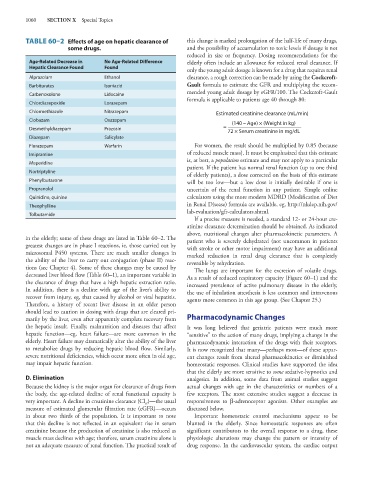Page 1074 - Basic _ Clinical Pharmacology ( PDFDrive )
P. 1074
1060 SECTION X Special Topics
TABLE 60–2 Effects of age on hepatic clearance of this change is marked prolongation of the half-life of many drugs,
some drugs. and the possibility of accumulation to toxic levels if dosage is not
reduced in size or frequency. Dosing recommendations for the
Age-Related Decrease in No Age-Related Difference elderly often include an allowance for reduced renal clearance. If
Hepatic Clearance Found Found
only the young adult dosage is known for a drug that requires renal
Alprazolam Ethanol clearance, a rough correction can be made by using the Cockcroft-
Barbiturates Isoniazid Gault formula to estimate the GFR and multiplying the recom-
mended young adult dosage by eGFR/100. The Cockcroft-Gault
Carbenoxolone Lidocaine
formula is applicable to patients age 40 through 80:
Chlordiazepoxide Lorazepam
Chlormethiazole Nitrazepam Estimated creatinine clearance (mL/min)
Clobazam Oxazepam (140 – Age) × (Weight in kg)
Desmethyldiazepam Prazosin =
72 × Serum creatinine in mg/dL
Diazepam Salicylate
Flurazepam Warfarin For women, the result should be multiplied by 0.85 (because
Imipramine of reduced muscle mass). It must be emphasized that this estimate
is, at best, a population estimate and may not apply to a particular
Meperidine
patient. If the patient has normal renal function (up to one third
Nortriptyline
of elderly patients), a dose corrected on the basis of this estimate
Phenylbutazone will be too low—but a low dose is initially desirable if one is
Propranolol uncertain of the renal function in any patient. Simple online
Quinidine, quinine calculators using the more modern MDRD (Modification of Diet
Theophylline in Renal Disease) formula are available, eg, http://nkdep.nih.gov/
lab-evaluation/gfr-calculators.shtml.
Tolbutamide
If a precise measure is needed, a standard 12- or 24-hour cre-
atinine clearance determination should be obtained. As indicated
above, nutritional changes alter pharmacokinetic parameters. A
in the elderly; some of these drugs are listed in Table 60–2. The patient who is severely dehydrated (not uncommon in patients
greatest changes are in phase I reactions, ie, those carried out by with stroke or other motor impairment) may have an additional
microsomal P450 systems. There are much smaller changes in marked reduction in renal drug clearance that is completely
the ability of the liver to carry out conjugation (phase II) reac- reversible by rehydration.
tions (see Chapter 4). Some of these changes may be caused by The lungs are important for the excretion of volatile drugs.
decreased liver blood flow (Table 60–1), an important variable in As a result of reduced respiratory capacity (Figure 60–1) and the
the clearance of drugs that have a high hepatic extraction ratio. increased prevalence of active pulmonary disease in the elderly,
In addition, there is a decline with age of the liver’s ability to the use of inhalation anesthesia is less common and intravenous
recover from injury, eg, that caused by alcohol or viral hepatitis. agents more common in this age group. (See Chapter 25.)
Therefore, a history of recent liver disease in an older person
should lead to caution in dosing with drugs that are cleared pri-
marily by the liver, even after apparently complete recovery from Pharmacodynamic Changes
the hepatic insult. Finally, malnutrition and diseases that affect It was long believed that geriatric patients were much more
hepatic function—eg, heart failure—are more common in the “sensitive” to the action of many drugs, implying a change in the
elderly. Heart failure may dramatically alter the ability of the liver pharmacodynamic interaction of the drugs with their receptors.
to metabolize drugs by reducing hepatic blood flow. Similarly, It is now recognized that many—perhaps most—of these appar-
severe nutritional deficiencies, which occur more often in old age, ent changes result from altered pharmacokinetics or diminished
may impair hepatic function. homeostatic responses. Clinical studies have supported the idea
that the elderly are more sensitive to some sedative-hypnotics and
D. Elimination analgesics. In addition, some data from animal studies suggest
Because the kidney is the major organ for clearance of drugs from actual changes with age in the characteristics or numbers of a
the body, the age-related decline of renal functional capacity is few receptors. The most extensive studies suggest a decrease in
very important. A decline in creatinine clearance (Cl )—the usual responsiveness to β-adrenoceptor agonists. Other examples are
cr
measure of estimated glomerular filtration rate (eGFR)—occurs discussed below.
in about two thirds of the population. It is important to note Important homeostatic control mechanisms appear to be
that this decline is not reflected in an equivalent rise in serum blunted in the elderly. Since homeostatic responses are often
creatinine because the production of creatinine is also reduced as significant contributors to the overall response to a drug, these
muscle mass declines with age; therefore, serum creatinine alone is physiologic alterations may change the pattern or intensity of
not an adequate measure of renal function. The practical result of drug response. In the cardiovascular system, the cardiac output

